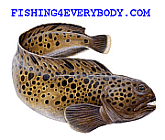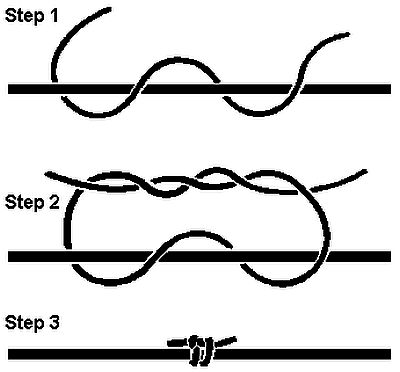
|
 Fishing hooks Fishing hooks
|
 Fishing line Fishing line
|
|
How to tie fishing line together?

|
| Bobber stop knot. Use thinner line to make this knot around the thicker monofilament line. |
Tie broken fishing line together
During fishing, the line can be broken or seriously damaged at any time. You can spot some signs of excessive tearing on some part of the line, and in this case it is much better to cut them off and tie two lines together.| Blood knot is the best knot for tie two fishing lines of the similar size. This knot is very slim and easily go trough rod eyes under any load and any speed. I would like to say, that the blood knot is one of the most important knots for the fishemen. |
The best way to join two similar fishing line together is to use blood knot. The knot charges it structure by itself under the load. When making the blood knot, it is necessary to make from five up to seven twists of each line. The video in this section explains how to make this knot much better, than hundreds words, so just watch it and repeat few times. At the beginning it is much better to repeat knot many times to memorize for the rest of the life how to tie fishing line together. Take your time and practice a bit.
Joining thin and thick fishing line
The most common task is joining a shock leader to the main fishing line. For successful long casting, fishing tackle should have proper, thick shock leader. For example, if the main line is 0.4mm, then the shock leader should be about 0.6mm-0.7mm line. The selection of proper shock leader we will discuss somewhere else, but here we will learn, how to attach it to the main line.We've compared plenty of different fishing line knots, and still do believe, that for joining thin and thick line, the blood knot is one of the best. Someone can say, that allbright knot is better to joining the different lines, but it is not very god for monofilament line, because it will wave strong line end-bits, which can catch the rod eye. Albright knot is perfect to join braided line to the monofilament line.
Making fishing line branches
Very often, the short line with the fishing hook should be attached to the main line, or to the shock leader.| Drooped loop knot. Very useful knot for making loop on the main thick fishing line. Later on you can attach anything to this loop. |
Basically, we need to make a loop on the line, and later use this loop to attach anything we like, including other lines. The most suitable is a dropper loop fishing knot. See the video, how no make it. For twisting the line sometimes it will be very convenient to use small stick, like cocktail stick or just a simple match.
Bobber stop knot
The fishing line sometimes should be equipped with something on it, which can limit the movement of a float along the line. This bulky knot should stay well on the same place, but from other hands, this knot should be easy movable along the main line. The best way is to attach thinner fishing line to the main line by the bobber stop knot. This knot stay very tightly on the monifilament line, but can be shifted by hands.Again it is very easy to understand this knot by looking at the picture in this article.
Then you can attach other line to the loop by many ways, some of them will be described in the article about attaching fishing line to the ring or to the eye.
Now you know, how to tie fishing line together, but we would like to give the last remark. Fishing line can be seriously damaged by overheating, but nobody realize that during tightening of any knots, the line within the knot is seriously heated. To avoid this you should always moisturise the knot before the final tightening. This will increaser the heat sink and provides some lubrication for the line for better tightening.
see also
 Fishing tackle shop near meHow to find nearest fishing tackle shop to home and is there are any point to go there? ...
Fishing tackle shop near meHow to find nearest fishing tackle shop to home and is there are any point to go there? ... Fishing hooks UKWhich fishing hooks can be used in UK for coarse and sea fishing. ...
Fishing hooks UKWhich fishing hooks can be used in UK for coarse and sea fishing. ... Barbless hooks for fishingWhat is the barbless hooks, why are they used and how to use them you will learn in this review. ...
Barbless hooks for fishingWhat is the barbless hooks, why are they used and how to use them you will learn in this review. ...
F4E about and privacy contacts
© 2014 FISHING4EVERYBODY “Fishing for Everybody”
All materials available on this site are protected by copyright laws and international copyright treaty provisions. (с) fishing4everybody.com